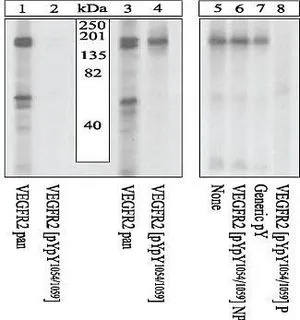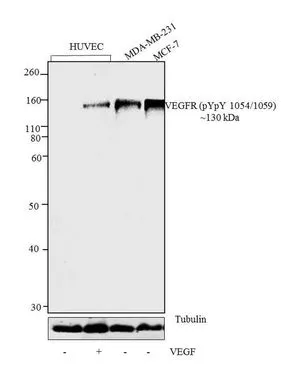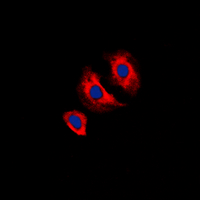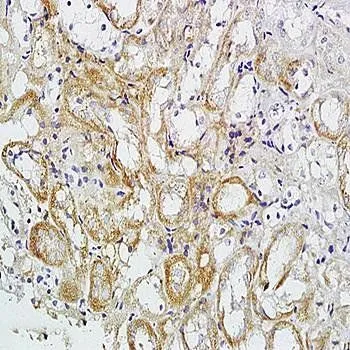
WB analysis of PAE cells transfected with a chimeric receptor unstimulated (Lane 1, 2) or stimulated with 40ng/mL CSF-1 for 10 minutes (Lane 3-8) using GTX25473 VEGF Receptor 2 (phospho Tyr1054/Tyr1059) antibody.
VEGF Receptor 2 (phospho Tyr1054/Tyr1059) antibody
GTX25473
ApplicationsFlow Cytometry, ImmunoFluorescence, Western Blot, ImmunoCytoChemistry
Product group Antibodies
TargetKDR
Overview
- SupplierGeneTex
- Product NameVEGF Receptor 2 (phospho Tyr1054/Tyr1059) antibody - Orthogonal Validated
- Delivery Days Customer9
- Application Supplier NoteWB: 1:1000. ICC/IF: 1:250. FACS: 1:20. *Optimal dilutions/concentrations should be determined by the researcher.Not tested in other applications.
- ApplicationsFlow Cytometry, ImmunoFluorescence, Western Blot, ImmunoCytoChemistry
- CertificationResearch Use Only
- ClonalityPolyclonal
- ConjugateUnconjugated
- Gene ID3791
- Target nameKDR
- Target descriptionkinase insert domain receptor
- Target synonymsCD309, FLK1, VEGFR, VEGFR2, vascular endothelial growth factor receptor 2, fetal liver kinase-1, kinase insert domain receptor (a type III receptor tyrosine kinase), protein-tyrosine kinase receptor Flk-1, soluble VEGFR2, tyrosine kinase growth factor receptor
- HostRabbit
- IsotypeIgG
- Protein IDP35968
- Protein NameVascular endothelial growth factor receptor 2
- Scientific DescriptionVascular endothelial growth factor (VEGF) is a major growth factor for endothelial cells. This gene encodes one of the two receptors of the VEGF. This receptor, known as kinase insert domain receptor, is a type III receptor tyrosine kinase. It functions as the main mediator of VEGF-induced endothelial proliferation, survival, migration, tubular morphogenesis and sprouting. The signalling and trafficking of this receptor are regulated by multiple factors, including Rab GTPase, P2Y purine nucleotide receptor, integrin alphaVbeta3, T-cell protein tyrosine phosphatase, etc.. Mutations of this gene are implicated in infantile capillary hemangiomas. [provided by RefSeq, May 2009]
- Storage Instruction-20°C or -80°C,2°C to 8°C
- UNSPSC12352203




![Activation assay analysis of HUVECs pre-treated with 5.0 and 25 microg/ml GTX53462 VEGF Receptor 2 antibody [6B11] and then stimulated with rhVEGF (10ng/ml) for 30min. The phospho-VEGFR2 was detected by detected with IP-Western for P-Tyrosine.](https://www.genetex.com/upload/website/prouct_img/normal/GTX53462/GTX53462_20191119_Activation_w_23060900_230.webp)
![Activation assay analysis of HUVECs stimulated with 20ng/ml VEGF or treated with 5.0 and 25 microg/ml GTX53464 VEGF Receptor 2 antibody [8A01] (30mins). Phospho-VEGFR2 was detected with IP-Western for P-Tyrosine.](https://www.genetex.com/upload/website/prouct_img/normal/GTX53464/GTX53464_20191119_Activation_w_23060900_578.webp)
![FACS analysis of HepG2 cells using GTX83308 VEGF Receptor 2 antibody [4B4]. Green : VEGF Receptor 2 Purple : negative control](https://www.genetex.com/upload/website/prouct_img/normal/GTX83308/GTX83308_20170912_FACS_w_23061322_153.webp)


